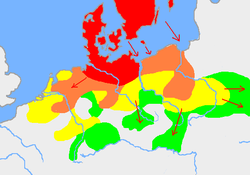

Iron Age Scandinavia (or Nordic Iron Age) was the Iron Age, as it unfolded in Scandinavia. It was preceded by the Nordic Bronze Age.


Iron Age Scandinavia (or Nordic Iron Age) was the Iron Age, as it unfolded in Scandinavia. It was preceded by the Nordic Bronze Age.
The 6th and 5th centuries BC were a tipping point for exports and imports on the European continent. The ever-increasing conflicts and wars between the central European Celtic tribes and the Mediterranean cultures destabilized old major trade routes and networks between Scandinavia and the Mediterranean, eventually breaking them down. Archaeology attests a rapid and deep change in the Scandinavian culture and way of life due to various reasons which have not yet been sufficiently analyzed. Agricultural production became more intensified, organized around larger settlements and with a much more labour-intensive production. Slaves were introduced and deployed, something uncommon in the Nordic Bronze Age. The rising power, wealth and organization of the central European tribes in the following centuries did not seem to instigate an increased trade and contact between Scandinavia and central Europe before 200‒100 BC. At this point the Celtic tribes had organized themselves in numerous urban communities known as oppida , and the more stable political situation in Europe allowed for a whole new economic development and trade. [3]
Bronze could not be produced in Scandinavia, as tin was not a local natural resource, but with new techniques, iron production from bog iron (mostly in Denmark) slowly gained ground. Iron is a versatile metal and was suitable for tools and weapons, but it was not until the Viking Age that iron incited a revolution in ploughing. [4] Previously, herds of livestock had pasture grazed freely in large wood pastures, but were now placed in stables, probably to utilize manure more efficiently and increase agricultural production. Even though the advent of the Iron Age in Scandinavia was a time of great crisis, the new agricultural expansions, techniques and organizations proceeded apace. And though the decline of foreign trade might suggest that the period marked a transition from a rich and wealthy culture to a poor and meagre one, the population grew and new technology was developed. The period might just reflect a change of culture and not necessarily a decline in standards of living. [3]
The Iron Age in Scandinavia and Northern Europe begins around 500 BC with the Jastorf culture, and is taken to last until c. 800 AD and the beginning Viking Age. It succeeds the Nordic Bronze Age with the introduction of ferrous metallurgy by contact with the Hallstatt D/La Tène cultures.
The Northern European Iron Age is the locus of Proto-Germanic culture, in its later stage differentiating into Proto-Norse (in Scandinavia), and West Germanic (Ingvaeonic, Irminonic, Istvaeonic) in northern Germany.